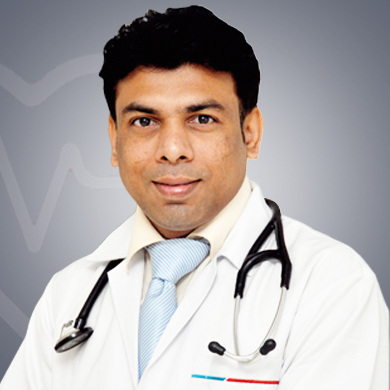
10 Years of experience
Speaks: English
Dr. Parvatagouda has an experience of more than 14 years and is an expert in cardiac surgery. In the year 2005, he completed his MBBS from Rajiv Gandhi University of Health Sciences, Karnataka. Later, in 2009, he was awarded MD in Medicine by Rajiv Gandhi University of Health Sciences, Karnataka. From DR RML Hospital and PGIMER, New Delhi, Dr. Parvatagouda completed DM in cardiology in 2016. He has prior experience of working at Gurunanak Dev Super specialty hospital New Delhi and is currently providing his services at VPS Rockland Hospital, Dwarka, New Delhi.
Dr. Parvatagouda C has a keen interest in Congenital heart diseases, Angiography, Renal, and Peripheral Angioplasty, Coronary Angioplasty Pacemakers, ICD, and CRT. He is highly experienced in Cardiac and cardio-thoracic surgeries and is expert in performing Heart Valve Replacement, Carotid Angioplasty, Coronary Balloon Angioplasty with Soluble Stent, Heart Arrhythmias Repair, Transcatheter Aortic Valve Implantation, Digital Subtraction Angiography, and Pediatric Coronary Angiography.
There are a number of conditions that are treated by Dr. Parvatagouda C as an interventional cardiologist and they are mentioned here.
It is important to resolve structural heart conditions in a patient and this can be achieved through interventional procedures. Patients with these heart conditions can be provided with best treatment with the assistance of modern technology and world class equipments. Quality post procedural care is a sign of the patient focused approach by the doctors who ensure that such conditions find the right solution.
Please see symptoms present in patients with non-coronary cardiovascular or structural diseases:
Chest pain and fatigue are some of the most common symptoms that people with such heart conditions show. It is important for you to monitor your blood pressure regularly and incase it is high for long periods of time then it could be because of a structural issue. Kidney dysfunction is also the result of lingering structural heart issues in a patient.
The operating hours of the doctor are between 10 am to 7 pm, Monday to Saturday. The doctor is known for quick treatment timeframe as he/she is skillful and efficient.
Dr. Parvatagouda C performs numerous popular interventional cardiology procedures as mentioned here::
For a long time now, interventional cardiologists have used techniques such as placement of stent, angioplasty and atherectomy to open blocked arteries. In order to treat cardiac arrhythmia, defibrillators and pacemakers are inserted in the heart routinely by doctors.

Share Your Experience about Dr. Parvatagouda C

In order to decipher your heart condition, interventional cardiologists prescribe or perform various diagnostic and screening tests. To resolve structural and cardiovascular heart conditions in a patient, the interventional cardiologists perform several procedures. Even in case of emergency heart situations such as a heart attack, you can go to this doctor. When faced with any symptoms or distressing situations related to your heart, this is the doctor you must approach.
We have outlined for you the several tests that are important before and during consultation with an Interventional Cardiologist:
The tests tie in with the treatment plan which can be decided upon basis your discussion with the doctor. The blood vessel and heart health become apparent after the test results come in.
Eating well, exercising regularly and a balanced lifestyle, no smoking or drinking ensures a healthy heart. Interventional cardiology techniques can help resolve the structural defects in your heart or cardiovascular issues if any. When heart issues are treated with catheter based procedures which do not involve surgery, then such procedures are done by Interventional cardiologists. Also, if your cardiologist feels that lifestyle and dietary changes will not help you they can redirect you to these doctors.